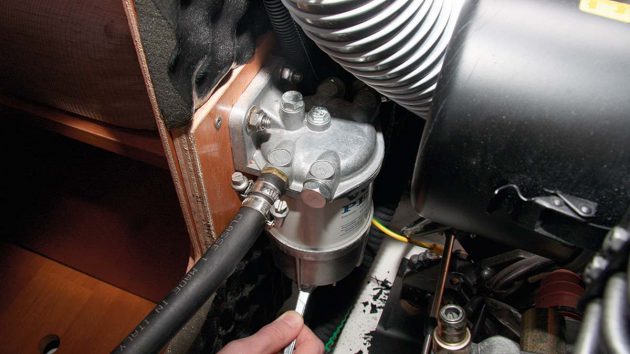PBO reader Kirk Forrest has a question about how to improve fuel filter efficiency. Engine whisperer Stu Davies has this advice...
Kirk Forrest writes: “I’ve been considering how to improve the fuel filter system on my 45-year-old Fisher 25 motor-sailer which has a Beta 28 engine. I bought the boat about five years ago and it has had quite a few owners.
“I filled the tank fully in the autumn as a precaution against fuel contamination, but who knows what the previous owners used to do? The boat currently has a CAV-type filter down in the bowels of the engine space, and it’s the only filter before the fine filter on the engine.
“I’d like to fit a Racor fuel polishing system but could this be mounted higher up in order to make it more visible and accessible? I was considering keeping the CAV as a primary filer (if only because I already have it and replacement cartridges are less expensive) followed by a Racor.
Article continues below…
12 diesel bug treatments tested
Diesel bug can clog filters and starve your boat engine of fuel just when you need it most. Can diesel…
How I built a £500 marine fuel polishing system to protect my boat from dirty diesel
Give our diesel engines clean fuel to drink, plenty of fresh air to breathe, plus a regular jump-start of amps,…
“The key aspect of this modification is to make the filters more accessible. Can they be raised and if so, does that necessitate an electric lift-pump? If so, will that require a constant electric supply while the engine is running?
“The boat has a 1/2/all switch which I alternate between batteries for engine start. I can’t envisage maintaining this practice while ensuring power for an electric pump. What do you suggest?
“To compound the problem of changing systems there is no tank drain or top access. Retaining the existing exit tap to help extract sludge might help but better filtration is obviously the way to go.”

Easily accessible Racor fuel filter system. Photo: John Willis
PBO engine expert Stu Davies replies: “The good old CAV 296 filter system has been going since I was an apprentice over 50 years ago. It works well, usually with a rating of 5 microns.
“As the years have gone by I’ve seen them used more as a primary filter with a secondary filter closer to the engine. They can be a pain to change with O-rings falling out of place as the bolt is inserted to hold it all together, and changing it is not for the faint hearted in a big sea, especially in the bowels of a boat behind a hot, smelly, diesel engine!
“There could be an argument that if it has worked okay for 45 years and there are no issues then why change it? If you check your CAV filter and it’s relatively clean after 100 hours then that indicates the tank should be clean too.

A CAV-type fuel filter and water separator bowl. Photo: ASAP Supplies
“Provided the lift pump is good simply changing the position of the CAV and sticking with what you’ve got should not be an issue – but bear in mind that with an older lift pump the higher up the filters are, the more chance there is of a leak developing on the suction side.
“Electric lift pumps sold as aftermarket replacements are readily available. However, a twin filter Racor system with a change over valve makes perfect sense – although it will cost more than a few beer tokens!
“You have a valve to shut off the fuel tank, so that would allow drainage of the tank and allow some cleaning with a bottle brush or such like and flushing with clean diesel. I’d also investigate whether it is possible to access the inside of the tank through the fuel level sensor as I do.
“Then, if the lift pump is good (maybe fit an aftermarket electric replacement and power it from your ignition switch if not), a Racor system could be fixed to one of the bulkheads near the engine and piped in.
“Some people swear by copper pipe for fuel lines although most production boats, such as mine, nowadays use fire-resistant flexible hose.”
Got a question? Email pbo@futurenet.com and we’ll put it to our panel of experts.
Why not subscribe today?
This feature appeared in the October 2023 edition of Practical Boat Owner. For more articles like this, including DIY, money-saving advice, great boat projects, expert tips and ways to improve your boat’s performance, take out a magazine subscription to Britain’s best-selling boating magazine.
Subscribe, or make a gift for someone else, and you’ll always save at least 30% compared to newsstand prices.
See the latest PBO subscription deals on magazinesdirect.com






